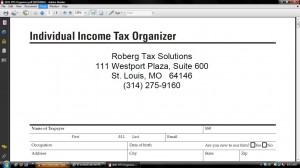I’ve said it before: I think Turbo Tax is a great product. I also like 1040.com, the do it yourself software you can get on my website. Good products, good results. But, they’re not perfect—none of them are. And neither are tax preparers, after all they are human and make mistakes as well.
It’s August, generally quiet time in the tax business—but no, not this week. The other day my phone rang nine times—people getting IRS letters. “Hello, I got an IRS letter, what do I do?” I suspect that the IRS must have done a mass mailing the other day for my phone to ring so much. (My phone is usually slow in August.)
Some calls are easy and I can guide someone over the phone, “Oh, just send them a copy of XYZ form, that’s all they want.” Usually though, people need to come in and have me take a look. What I’m often finding this summer—is that people are getting IRS letters saying folks owe money, but when I review their returns, they should be getting a refund instead. And while I think that’s great fun (because I’m a tax geek and that’s the kind of stuff I live for) most people don’t like getting IRS letters saying they owe thousands of dollars at all. (Although they’re usually happy when I show they’ve got a refund coming.)
But here’s the catch—these people wouldn’t know they had money coming back if the IRS didn’t send them the nasty letter in the first place! What about all the people who left money on the table but won’t get an IRS notice?
What I’m finding is that the people with money coming back did their own taxes with Turbo Tax. Not that the Turbo Tax program made a mistake but it is usually just a misunderstanding of what should or should not be listed or possibly a typo. That’s why I’m recommending a three year tax review.
Why three years? If you made a mistake on your tax return, you have three years from the date of filing to file an amendment to get your money back. This is achieved by filing a Form 1040X.
For example, let’s say back on your 2009 tax return, you typed in that you paid $1,000 in mortgage interest when really you paid $10,000. The two numbers look pretty similar but there’s $9,000 worth of deduction there that you just missed out on. If you’re in the 25% tax bracket, that’s a $2,250 refund that you’d be entitled to. Your 2009 tax return was due on April 15, 2010. So, three years from that date is April 15, 2013. If you wanted to get that money back from the IRS, you’d need to file an amended return by then.
You don’t need to do this every year, just bring in three years worth of returns once every three years. Most places charge a fee, but it’s generally much lower than the cost of preparing your returns. (I know one large tax company used to advertise that they’d do it for free.)
If your returns are fine—then you’ve got peace of mind. If you’ve been doing something wrong—well then you’ve learned something. If you get money back—well then you know you did the right thing. It’s a winning situation all the way around.





